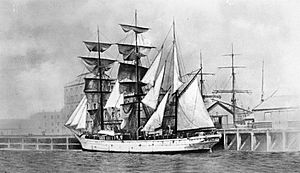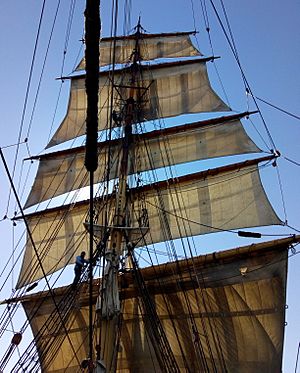James Craig (barque) facts for kids

James Craig in Geelong in 2006
|
|
Quick facts for kids History |
|
|---|---|
| Name |
|
| Owner |
|
| Builder | Bartram, Haswell & Co, Sunderland, England |
| Cost | £11,375 |
| Yard number | 75 |
| Launched | 18 February 1874 |
| Maiden voyage | England to Peru |
| In service | April,1874 |
| Renamed | James Craig, 1905 |
| Reclassified |
|
| Reinstated | February 2001 |
| Homeport | |
| Identification |
|
| Status | Museum ship since 1972 |
| General characteristics | |
| Type | Iron-hulled barque |
| Tonnage | 671 gross tons |
| Length |
|
| Beam | 31.3 ft (9.5 m) |
| Height | 108.2 ft (33.0 m) at mainmast |
| Draught | 12.3 ft (3.7 m) |
| Depth of hold | 18 ft (5.5 m) |
| Sail plan | Barque rig, 21 sails |
| Speed | 14 knots (26 km/h; 16 mph) |
| Capacity | 1,100 tons |
| Complement | 16 |
The James Craig is a beautiful three-masted sailing ship from the 19th century. It has an iron hull and is a type of ship called a barque. Today, it is carefully restored and sailed by the Sydney Heritage Fleet in Sydney, Australia. It is very special because it's one of only four ships of its kind from before the 20th century that still sails on the open sea.
Contents
A Long History at Sea
The James Craig was built in 1874 in Sunderland, England. When it was first launched, its name was Clan Macleod. It was designed to be a "workhorse" ship, meaning it was built to work hard and carry all sorts of cargo around the world. It transported goods like coal, salt, and grain.
For 26 years, the ship sailed across the globe. It even rounded the dangerous Cape Horn at the tip of South America 23 times!
A New Name and New Journeys
In 1900, a new owner from New Zealand, Mr. J. J. Craig, bought the ship. In 1905, he renamed it James Craig. The ship then started sailing between New Zealand and Australia. It made 35 trips across the Tasman Sea.
By the early 1900s, new steamships were becoming more popular. They were faster and more reliable than sailing ships. The James Craig couldn't compete. In 1911, it was turned into a floating storage shed, called a hulk, in Port Moresby.
During World War I, there was a shortage of ships. The James Craig was given a second chance. It was fixed up and started carrying cargo in the Pacific Ocean again. But this didn't last long. After the war, steamships took over for good.
Abandoned and Saved
In 1925, the James Craig was no longer needed. It was left in Recherche Bay in Tasmania. To stop it from floating away and causing problems for other boats, a hole was made in its stern, and it sank in the shallow water. For many years, it seemed like the end of the ship's story.
Bringing a Legend Back to Life
The idea to save the James Craig came from people who wanted to preserve history. In 1972, a group of volunteers from what is now the Sydney Heritage Fleet decided to rescue the ship. They managed to make it float again and towed it to Hobart for some early repairs.
In 1981, the ship was towed to Sydney. The real restoration work began. The hull was badly damaged, so it was lifted onto a special platform. This allowed workers to repair it properly. For over 25 years, skilled craftspeople and many volunteers worked to rebuild the ship. Most of the iron hull had to be replaced.
Finally, in 1997, the ship was launched back into the water. The restoration was fully completed in 2001.
The James Craig Today
Today, the James Craig is a floating museum. You can visit it at Wharf 7 in Darling Harbour, Sydney. It's right near the Australian National Maritime Museum.
The ship is not just for looking at. It also takes passengers on sailing trips around Sydney Harbour and even out to sea. A crew of dedicated volunteers from the Sydney Heritage Fleet sails the ship.
Keeping a historic ship like this in good condition is expensive. It costs over $1 million a year. This money comes from visitors, special events, and the sailing trips.
The ship often sails to other cities. It has made many trips to Hobart for the Wooden Boat Festival. It has also visited Melbourne and Williamstown.
In October 2013, the James Craig was part of a huge event called the International Fleet Review in Sydney.
Why is the James Craig So Important?
The James Craig is incredibly valuable to history. It is a real, working link to the past. It shows us how goods were moved around the world before modern cargo ships. Thousands of ships just like it once sailed the oceans, connecting countries and continents.
In 2003, the World Ship Trust gave the James Craig an award for its amazing and authentic restoration.
The ship is sailed using traditional 19th-century methods. The crew uses 140 different ropes, called lines, to control the sails. It's a true piece of living history.
Engineering Heritage Award
The James Craig was recognized for its importance to engineering history. It received an Engineering Heritage National Marker from Engineers Australia. This award honors it as a great example of 19th-century shipbuilding.
Gallery











